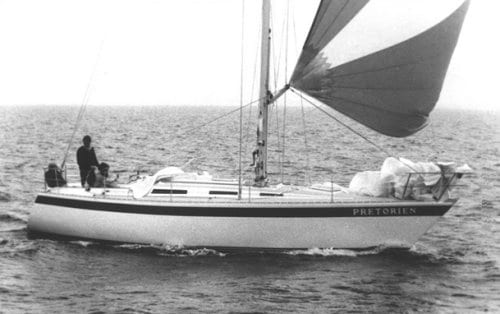
Recognizable by their distinctive blue sheer stripe, the boats produced by Chantiers Wauquiez, founded in 1965 and since 1997 part of the Beneteau Group, are highly regarded both for their sailing performance and for the quality of their construction.
The 35-foot Prétorien (a term that designates a soldier of the emperor’s guard), of which 212 were built between 1979 and 1986, is a Holman & Pye design. The IOR’s influence is visible in its lines and in the high-aspect-ratio mainsail, but the Prétorien doesn’t have the extreme tumblehome or pinched stern that haunt many designs of the era. A 3-ton keel, bolted externally to a deep stub, keeps the boat on its lines when the breeze pipes up, a long waterline ensures good speeds, and the deep, skeg-hung rudder provides excellent control.
Wide side decks, part of the “Euro-design” look of a low cabin trunk merging into a flush deck forward, are clean and safe for moving about. The aft cockpit is snug and comfortable under sail and at anchor, but the placement of winches and the bridgedeck traveler make it difficult to fit a useful dodger.
Varnished teak with a beeswax finish sets the tone below. To starboard is a U-shaped galley with large storage cabinets and lockers, double round (but shallow) sinks, and the Wauquiez trademark: brown ceramic-tile countertops. The nav table to port is large enough to hold a folded chart and is well provided with bookshelves and space for instruments.
Aft, on the port side, there’s a cozy double cabin with a hanging locker. Under ample headroom, the main saloon has a large, centerline table, a U-shaped convertible banquette to starboard, and a single sea berth with lee cloth to port. A mirrored, felt-lined liquor locker and a wine cellar under a settee speak to the innate French epicure. Forward on the starboard side is the head, with a roomy hanging locker opposite. The large V-berth is surrounded by useful, accessible storage.
Henri Wauquiez demanded high-quality construction in the boats that bear his name. The Prétorien’s hull is solid fiberglass, laid up with 18-ounce fabric, not 24-ounce, because resin saturation of the lighter cloth is achieved more reliably. Wauquiez laid the deck’s balsa coring in strips with spaces between them and coated these with resin before fitting the alternating strips. Should a leak occur, this detail inhibits water damage.
Because of Henri’s desire to build to Lloyd’s Rules, which, at the time, hadn’t certified any opening portlights, ventilation is marginal, despite three opening hatches, two “UFO” vents forward, and a couple of cowl vents in the saloon. Several owners have installed opening ports.
Most of the boats were built with Volvo sail drives, the 28-horsepower MD11C engine pushing the boat along comfortably at 6.5 knots. Many have by now been rebuilt or replaced. I used the Volvo replacement kit for the MD2030C (under $9,000).
Access to the engine compartment is via a couple of panels at the companionway, another in the starboard cockpit locker, and a small hatch in the aft cabin locker.
I surveyed the many owners who participate on the SailNet Wauquiez e-mail list and discovered remarkable loyalty to the marque—the average ownership was nine years, and several had moved up from smaller to larger Wauquiez boats. The Prétorien was never inexpensive and has held its value. Typical asking prices for these classy boats range from $75,000 to $90,000.
John and Lisa Caruso are preparing their Prétorien 35, Andiamo, for a 10-year cruise.








